|
|
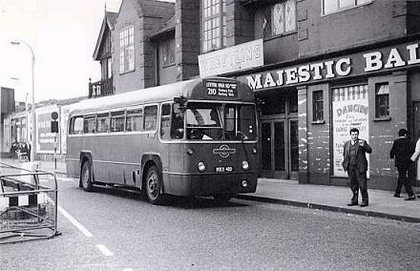 Red RF routes Red RF routes
Route 210
Page last updated 21 September
2019
This historic route from Golders Green to Finsbury Park has been virtually
unchanged (apart from renumbering from 110 to 210
in 1934) since 1922, although it was extended to Brent Cross
in the 1970s. It was the first Central Area route to operate
RFs.
Sometime between 1963 and
1968, when Leyton garage worked the 210 through to Leyton High Road
on Sundays in place of the 236, RF433 is
seen in Stroud Green Road. The bus has just made the
transition from the weekday 210 route, having passed under the low
bridge at Finsbury Park Station. Having been a venue for
(amongst others) The Beatles, in 1963, the Majestic Ballroom is no
more. Photo: John Hinson
collection
Dates of RF
operation
11 Sep 52 to 17 Sep 71
Conversion to OMO: 24 Jan 70
(total 19 years, of which 17
years 4 months crew operation)
Destinations
GOLDERS GREEN and FINSBURY PARK
Sunday extensions:
GOLDERS GREEN and LEYTON Hainault Road (27 Jan
63 to 1 Sep 68)
GOLDERS GREEN and LEYTONSTONE STATION (8 Sep 68 to 18 Jan
70)
RF garages
MH Muswell Hill (throughout)
AR Tottenham (Sundays, 27 Jan 63 to 18 Jan
70)
T Leyton (Sundays, 27 Jan 63 to
18 Jan 70)
HT Highgate (from OMO conversion 24 Jan
70)
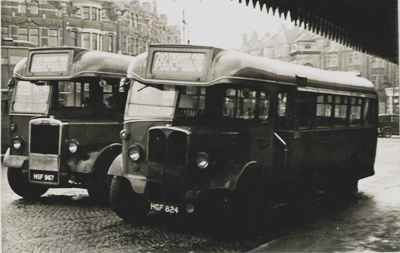 Reason for single-deck operation Reason for single-deck operation
With no low bridges, the
210 is said to have been always single-deck because of a steep
camber and roadside trees along the stretch of road west of The
Spaniards, although an application in 1963 by London Transport to
the Conservators of Hampstead Heath for double-decking is reported
to have been denied, suggesting that residents were not keen on
passengers looking over their fences. Contrary to some
reports, the railway bridge over Wells Terrace to the coal
sidings at Finsbury Park (now
removed) was not an impediment to double-deck working. The
route remained single-deck operated until February 2008.
Leyland vs AEC at Golders Green on the 210;
TD9 and T734 bear the same style of Weymann bodywork. This is
April 1947, during the period when the 14T12s were being replaced
on the 212 by the first batch of TDs; the
majority allocation on the 210 was still elderly
Scooters. Photo Peter Osborn collection
Route history
The Golders Green to Finsbury Park route started as the 110 on
12 Apr 22, initially using three 20-seat B-types working from
Holloway Garage (J) and covering new roads in Hornsey and
across Hampstead Heath. The Traffic
Circulars suggest that there was an original intention to use
double-deckers, but this was not to be for over 85 years. In
1924, the weekday allocation was doubled and the Sunday service
increased to 12 buses. In September 1925, the new
Muswell Hill Garage (MH) joined J for the Sunday
operation.
Initially, the terminus at Finsbury
Park was in Station Place, along with route 111, meaning that the routes passed under the low
bridge in Stroud Green Road. On 8 Mar 26, the Wells Terrace
terminus opened, initially with an anti-clockwise working and
changing to clockwise on 17 Dec 30.
Scooters were the mainstay
of the 210 from new until withdrawal in 1952. Here the crew
of LT1010 have been joined on the Finsbury Park Wells
Terrace stand by the conductor of the bus behind.
Photo © Alan
Cross
Both J and MH replaced their Bs with K-types during 1927, with
April of that year seeing MH taking sole charge of Sunday operation
for the summer but losing all involvement that October. The
next two summers saw MH and J sharing operation on Sundays,
with MH providing 8 buses to supplement J's daily allocation of
9. MH continued through the winter to 1930, when April saw
Cricklewood (W) take over the extra Sunday duties, just for that
summer (W was not to be involved again until 2009). New AEC
Regal Ts replaced most of the K class on the 110 at J at
the end of 1929 (ten buses in the range T32-46).
Larger LT 'Scooters' were delivered new in 1931, with J
receiving the second allocation after MH's for the 111 (later
renumbered 212 and MH's only single-deck
route at the time). The 24 Scooters delivered to J replaced
the smaller 1T1s on the 110 and 41 A (later 232), although two Ks were retained for
Saturday use on the 110. MH had restarted for the
summer Sundays on 1 April and Scooters appeared that month, spare
from the 111 as that route provided a less frequent service on
Sunday. The pattern of extra summer Sunday buses from MH
continued until 1934, helping to shift the heavy
weekend Hampstead Heath leisure traffic, when on 16 May the
allocation moved across wholesale and J's role was reduced to minor
weekend support. This allowed J to increase its work on route
19.
The route was renumbered as 210 in the single-deck
sequence on 3 Oct 34, with an MH
allocation of 7/9/14 buses (M-F/Sa/Su). Apart from the
1934/35 winter, when MH operated the route unaided, J
continued to operate some workings alongside MH, initially at
weekends when the route was busiest and daily (except winter
Sundays) at an increased level from 1936, until the end of
1939.
The Scooter allocation at Muswell Hill peaked at 50 buses
in September 1945, as detailed in David Ruddom's article in LHRG
Bulletin 77 [see foot of page]. During the war, he records
that the interior livery was 'battleship grey' paint to the top of
the windows, replaced after the war by chocolate brown and an
apple-green rail above the windows. Two LTLs however had
STL-style green seat moquette and green and cream window
surrounds. Two Scooters at MH during the war were repainted
Indian Red (a sort of red-brown), but none had perimeter-seating
fitted; buses with this arrangement (which permitted increased
standing capacity) were occasionally borrowed from D, AR or T,
usually for Bank Holiday augmentation on the 210 for
the Hampstead Fair (see also Memories page
1).
By the end of 1946, sister route 212 was already replacing its Ts with new
TDs. A lower requirement at the weekends meant
that spare buses (Ts on Saturdays, TDs on Sundays) could be
scheduled on the 210 and the total requirement for Scooters could
be reduced. The TDs then shared the route with the LTs until
19 Mar 52, when a batch of ex-Green Line 6Q6s replaced the
remaining Scooters at MH on the 210 and 244. See the 212
for more detail on this period.
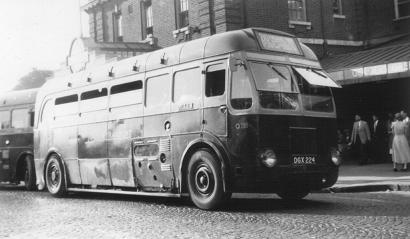 Ex-Green Line Q218, looking rather battered, stands
outside Golders Green underground station.
The 6Q6s, themselves replaced on the Green Line by RFs, were
of course a stopgap. With Green Line deliveries complete, the
first red RFs rolled off the production line in September
1952 and RFs 289, 291 and 293 were licensed on the 10th and
entered service to start the new era on the 11th. Ken
Glazier records that the drivers were trained on 5Q5s
(presumably scrounged temporarily from somewhere) for the set-back
wheel arrangement and RTs for basic controls; there was no
allocation of training RFs to MH. [See Stuart Perry's notes
on type-training on RFs here].
Stuart also reports Phil Wilsher as remembering driving the TD and
Q types alongside the RF in the transitional period, when it was
pot luck whether your duty would be on the brand new RF or perhaps
half and half. But RF allocation was complete by 10 October
and the 6Q6s were history.
However, the initial allocation was only 14 buses, just enough
for Monday to Friday, but TDs were still needed to help out at
the weekends. Indeed, the official weekend allocation of
15 RFs could not be met at first, but only a week later
(after the conversion of the 208A), a second batch of 15 new buses
started arriving. These were all licensed by 1 November;
as they arrived, the first 14 were released for
redistribution around other garages as training buses. TDs
continued to be required until the arrival of more RFs for the
212 in the new year, when the higher requirement on Monday to
Friday balanced the 210's higher weekend allocation.
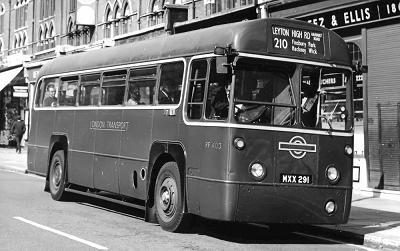 The 210 worked quietly away for many years, its initial
allocation reducing within the first year (possibly due to the
faster running times of the RFs) then stabilising. In 1969,
most of Muswell Hill's RFs were replaced by a batch of
green RFs from the Country area, which
ran on the 210 (by then the last RF route at MH) for several
months before being painted red. These buses became available
by a combination of reduced services and the introduction of MB
class Merlins in the Country Area.
RF403 is seen in Stroud
Green on a Sunday, working through to Leyton Hainault
Road, described on the blinds as Leyton High Road
Hainault Road.
In the early 1960s, a special RF-operated express service was introduced on summer Saturday
evenings between Golders Green and Archway Station, stopping only
at Kenwood. This served the audience of the open air concerts
at Kenwood House. The limited amount known about
these workings is set out here.
To the east of the 210, RF route 236 ran from Finsbury Park to Leyton through back
roads. From 3 Mar 63, the two routes were combined on
Sundays to form a single through route numbered 210, with
one in every two or three journeys from Golders Green running
through to Leyton. Muswell Hill's buses were joined by some
of Leyton (T) and Tottenham (AR)'s allocation from the
236. Cut back to Leytonstone in September 1968, along with
the weekday 236, the Sunday through journeys continued to
1971, but were renumbered 236 (and still crew operated) when the
210 was converted to OMO on 24 Jan 70.
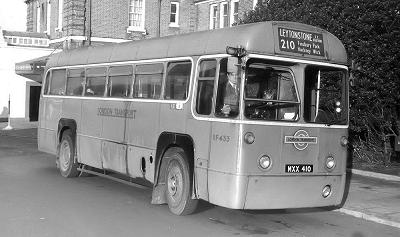 Between 1966 and 1969, the routing at Archway was
altered several times to permit the building of the one-way
system, and the Sunday routing in Hackney also changed several
times as for the 236. Between 1966 and 1969, the routing at Archway was
altered several times to permit the building of the one-way
system, and the Sunday routing in Hackney also changed several
times as for the 236.
With the conductor's Gibson catching the
light, Leyton's RF433 (again)
sets off from Golders Green on a Sunday through working to
Leytonstone. Photo © Colin Stannard
The route
continued with crew-operated RFs until 24 Jan 70, when these were
replaced by one-man operated RFs (with doors). With the
replacement of the Sunday through journeys by the 236, which
still used conductors, the whole of the OMO 210 route was also
covered on that day by crew-operated RFs on the 236.
Leyton and Tottenham ran the 236, whilst MH was joined on the 210
by Highgate (HT, since renamed Holloway) with 3 buses all week.
When the 236 lost its RFs (16 Apr 71), the Sunday through
journeys ceased and the 210 converted to AEC Swifts on that
day, keeping its RFs on weekdays until 17 September when they too
gave way to Swifts.
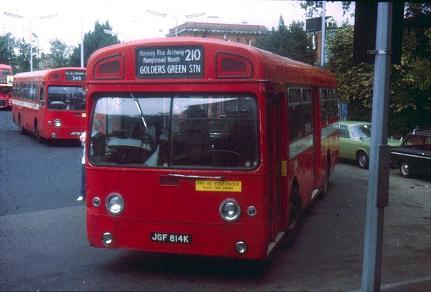
In January 1976, the route received a northward extension
to the soon-to-open Brent Cross Shopping Centre, to which it still
runs. In June 1978, the SMSs were replaced by Leyland
Nationals. The route continued to be operated by
both MH and HT until 1982, when MH took sole control until the
route was tendered and won by Grey Green in 1990. Grey Green
were replaced in 1998 by Thorpes, who were purchased by Metroline
in 2004.
AEC Swift SMS814 at
Golders Green.
Photo © Jeff Lloyd via
London Bus Scene
The route was converted to double-deck operation on 16 Feb
2008, using Tridents made spare from route 182. The
allocation was moved from Perivale West to Cricklewood in 2009 and
the Tridents replaced by Enviro400s on tender renewal in
2010.
RF route in detail, with timing points
GOLDERS GREEN STATION, North End Road, Hampstead Heath Jack Straws
Castle, Spaniards Road, Hampstead Lane, Highgate Village South Grove,
Highgate High Street, Highgate Hill, Highgate Archway Station, St
Johns Way, Hazellville Road, Hornsey Rise, Hanley Road,
Stroud Green
Stapleton, Stroud Green Road, FINSBURY PARK
Wells Terrace (return via Wells Terrace, Fonthill
Road, Lennox Road to Stroud Green Road, but see below for reversal
from 1961) (Daily 11 Sep 52 to 26 Jan 63, Mon-Sat 27 Jan
63 to 18 Jan 70, daily 19 Jan 70 to 16 Apr 71).
GOLDERS GREEN STATION, North End Road, Hampstead Heath Jack Straws
Castle, Spaniards Road, Hampstead Lane, Highgate Village South Grove,
Highgate High Street, Highgate Hill, Highgate Archway Station, St
Johns Way, Hazellville Road, Hornsey Rise, Hanley Road,
Stroud Green
Stapleton, Stroud Green Road, Finsbury Park Rock
Street, Blackstock Road, Highbury Park,
Highbury Barn Tavern,
Highbury Grove, Highbury New Park, Grosvenor Avenue, Mildmay Grove
North, King Henry’s Walk, Crossway, Stoke Newington Road, Shacklewell Lane, St
Mark’s Rise, Ridley Road, Dalston Lane, Queensbridge Road, Albion
Drive, Dalston Garage,
Lansdowne Drive, Westgate Street, Hackney Mare Street, King Edwards
Road, Lauriston Road, Cassland Road, (return via Victoria Park
Road, Fremont Street), Wick Road, Hackney Wick Eastway, Eastway,
Ruckholt Road, Leyton Town
Hall, Grove Green Road, Leytonstone Station, Fairlop Road,
Hainault Road, LEYTON Hainault Road (Sundays, 27 Jan
63 to 1 Sep 68).
GOLDERS GREEN STATION, North End Road, Hampstead Heath Jack Straws
Castle, Spaniards Road, Hampstead Lane, Highgate Village South Grove,
Highgate High Street, Highgate Hill, Highgate Archway Station, St
Johns Way, Hazellville Road, Hornsey Rise, Hanley Road,
Stroud Green
Stapleton, Stroud Green Road, Finsbury Park Rock
Street, Blackstock Road, Highbury Park,
Highbury Barn Tavern,
Highbury Grove, Highbury New Park, Grosvenor Avenue, Mildmay Grove
North, King Henry’s Walk, Crossway, Stoke Newington Road, Shacklewell Lane, St
Mark’s Rise, Ridley Road, Dalston Lane, Queensbridge Road, Albion
Drive, Dalston Garage,
Lansdowne Drive, Westgate Street, Hackney Mare Street, via
King Edwards Road, Ainsworth Road, Well Street,
Cassland Road (return via Victoria Park Road, Fremont Street), Wick
Road, Hackney Wick
Eastway, Eastway, Ruckholt Road, Leyton Town Hall, Grove Green
Road, LEYTONSTONE STATION (Sundays, 8 Sep 68 to 18 Jan
70).
GOLDERS GREEN STATION, North End Road, Hampstead Heath Jack Straws
Castle, Spaniards Road, Hampstead Lane, Highgate Village South Grove,
Highgate High Street, Highgate Hill, Highgate Archway Station, St
Johns Way, Sunnyside Road, Beaumont Rise, Hornsey Rise, Hanley
Road, Stroud Green
Stapleton, Stroud Green Road, Lennox Road, FINSBURY
PARK Clifton Terrace (return via Wells Terrace to Stroud
Green Road) (Daily 17 Apr 71 to 17 Sep
71)
Terminal working at FINSBURY PARK
changed 12 Jun 61 to arrive from Stroud Green Road via Lennox Road,
Clifton Terrace (stand) and depart via Wells Terrace to Stroud
Green Road. A one-way system in Highgate Village required a
rerouting eastbound via North Road, Castle Yard and Southwood
Lane from 7 Jul 63 until October 1993. Various
diversions around Archway from 1965-1969. The routing through
Hackney on Sundays changed as for the 236.
Map © London Transport 1955
Garage journeys
MH: to Archway Station, via Highgate Station (journeys to
Finsbury Park) or via Crouch End Broadway and Hornsey Rise
(journeys to Golders Green).
AR: to join line of route at Shacklewell Road, via Stamford
Hill and Kingsland High Road.
T: via Leyton High Road to Leyton Hainault Road (to 1 Sep
68), via Leyton High Road, Hainault Road, Fairlop Road to
Leytonstone Station (from 8 Sep 68)
HT: direct at Archway.
Frequency
| Year |
Mon-Fri |
Sat |
Sun |
| 1936 |
10 mins |
5 mins |
4 mins |
| 1941 |
10 mins |
8-10 mins |
4-6 mins |
| 1946 |
8 mins |
6-10 mins
|
3½-6 mins |
| 1951 |
5-7 mins |
4½-6 mins |
3½-6½ mins |
| 1959 |
6-11 mins |
5-10 mins |
3-5 mins |
| 1964 |
6-11 mins |
5-10 mins |
4-8 mins* |
| 1971 |
6-9 mins |
7½-12 mins |
18 mins |
* To Finsbury Park; through journeys to Leyton
every 12-15 mins
The route took approximately 30 minutes between Finsbury Park
and Golders Green. The November 1959 timetable is
here, the July 1967
timetable here.
Faretable
In the 1960s, the swapping of Sunday workings between 210 and
236 meant that faretables covered both routes. That for 1965
is here and that for 1969 is here. Both include the
(Sunday/236) Leyton and Tottenham garage workings, but not those
for Muswell Hill.
RF allocation
New RFs delivered Sep-Oct 52: 289-302 (14), these
transferred elsewhere as trainers, replaced Oct-Nov 52 by
315-323, 325-329, 332 (15).
PVR 1952: Mon-Fri 14, Sat 15 + 2 TD, Sun 15 + 5 TD
PVR 1963: Mon-Fri 11, Sat 12, Sun 30 (12 MH, 10 AR, 8 T)
PVR 1970 (OMO): Mon-Fri 12 (9 MH, 3 HT) , Sat 10 (7 MH, 3 HT),
Sun 6 (3 MH, 3 HT)
PVR 1971: Mon-Fri 12 (9 MH, 3 HT) , Sat 10 (7 MH, 3 HT), Sun
(SMS)
See below for detailed changes over the years.
Memories
Stuart Perry writes about
driving the 210 and other Muswell Hill routes here.
Mark Carrara writes to
supplement Stuart's stories, here.
Re-creation
 RFs operated on the 60th anniversary, 11 Sep 2012. In addition,
RF486 worked the 210 at the HT open days in 2007 and 2011.
Virtually unchanged, The
Spaniards on Hampstead Heath has watched the 210 squeeze past for
over 90 years. This is 2007.
Photo © Peter Osborn
RF allocation - detailed changes
PVR 1952 (Oct): Mon-Fri 14, Sat 15 + 2 TD, Sun 15 + 5
TD
PVR 1953 (May): Mon-Fri 14, Sat 17, Sun 26
PVR 1953 (July): Mon-Fri 13, Sat 16, Sun 26
PVR 1953 (Oct): Mon-Fri 12, Sat 13, Sun 17
PVR 1954 (May): Mon-Fri 12, Sat 13, Sun 23
PVR 1954 (July): Mon-Fri 12, Sat 13, Sun 22
PVR 1954 (Oct): Mon-Fri 12, Sat 13, Sun 16
PVR 1955 (May): Mon-Fri 11, Sat 12, Sun 22
PVR 1955 (Oct): Mon-Fri 11, Sat 12, Sun 15
PVR 1956 (May): Mon-Fri 11, Sat 12, Sun 22
PVR 1956 (Oct): Mon-Fri 11, Sat 12, Sun 16
PVR 1957 (May): Mon-Fri 11, Sat 12, Sun 23
PVR 1957 (Oct): Mon-Fri 11, Sat 12, Sun 16
PVR 1958 (Apr): Mon-Fri 11, Sat 12, Sun 23
PVR 1958 (Nov): Mon-Fri 10, Sat 12, Sun 16
PVR 1959 (May): Mon-Fri 10, Sat 12, Sun 23
PVR 1959 (Oct): Mon-Fri 11, Sat 12, Sun 16
PVR 1960 (May): Mon-Fri 11, Sat 12, Sun 23
PVR 1960 (Oct): Mon-Fri 11, Sat 12, Sun 16
PVR 1961 (May): Mon-Fri 11, Sat 12, Sun 23
PVR 1961 (Oct): Mon-Fri 11, Sat 12, Sun 19
PVR 1962 (May): Mon-Fri 11, Sat 12, Sun 23
PVR 1962 (Oct): Mon-Fri 11, Sat 12, Sun 19
PVR 1963 (Mar): Mon-Fri 11, Sat 12, Sun 30 (12 MH, 10 AR, 8
T)
PVR 1963 (May): Mon-Fri 11, Sat 12, Sun 33 (12 MH, 10 AR, 11
T)
PVR 1963 (Oct): Mon-Fri 11, Sat 12, Sun 26 (10 MH, 8 AR, 8
T)
PVR 1964 (Jul): Mon-Fri 11, Sat 12, Sun 30 (12 MH, 8 AR, 12
T)
PVR 1964 (Nov): Mon-Fri 11, Sat 12, Sun 24 (8 MH, 9 AR, 7 T)
PVR 1965 (Apr): Mon-Fri 11, Sat 12, Sun 27 (8 MH, 9 AR, 10
T)
PVR 1965 (Aug): Mon-Fri 12, Sat 12, Sun 27 (8 MH, 9 AR, 10
T)
PVR 1965 (Oct): Mon-Fri 12, Sat 12, Sun 24 (8 MH, 9 AR, 7 T)
PVR 1966 (Jul): Mon-Fri 12, Sat 11, Sun 24 (8 MH, 9 AR, 7 T)
PVR 1968 (Sep): Mon-Fri 12, Sat 11, Sun 23 (8 MH, 9 AR, 6 T)
PVR 1970 (Jan, OMO): Mon-Fri 12 (9 MH, 3 HT) , Sat 10 (7 MH, 3
HT), Sun 6 (3 MH, 3 HT)
PVR 1971 (Apr): Mon-Fri 12 (9 MH, 3 HT) , Sat 10 (7 MH, 3 HT),
(Sun SMS)
Early fleet details
Thanks to David Ruddom in
LHRG Bulletin 77, we can record that the first 25 Scooters at
MH were LT1001-12/4/6/7/21/23/4/8-33/5/6; LT1001 had first been
used on route 104, but the others were
new in April 1931.
|
|